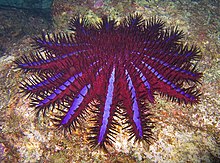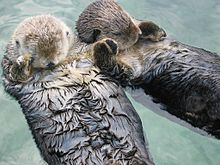Lifeforms
[edit]Microscopic life
Microscopic life undersea is incredibly diverse and still poorly understood. For example, the role ofviruses in marine ecosystems is barely being explored even in the beginning of the 21st century.
The role of phytoplankton is better understood due to their critical position as the most numerousprimary producers on Earth. Phytoplankton are categorized into cyanobacteria (also called blue-green algae/bacteria), various types of algae (red, green, brown, and yellow-green), diatoms,dinoflagellates, euglenoids, coccolithophorids, cryptomonads, chrysophytes, chlorophytes,prasinophytes, and silicoflagellates.
Zooplankton tend to be somewhat larger, and not all are microscopic. Many Protozoa are zooplankton, including dinoflagellates, zooflagellates, foraminiferans, and radiolarians. Some of these (such as dinoflagellates) are also phytoplankton; the distinction between plants and animals often breaks down in very small organisms. Other zooplankton include cnidarians, ctenophores,chaetognaths, molluscs, arthropods, urochordates, and annelids such as polychaetes. Many larger animals begin their life as zooplankton before they become large enough to take their familiar forms. Two examples are fish larvae and sea stars (also called starfish).
[edit]Plants and algae
Plant life is widespread and very diverse under the ocean. Microscopic photosynthetic algae contribute a larger proportion of the worlds photosynthetic output than all the terrestrial forests combined. Most of the niche occupied by sub plants on land is actually occupied by macroscopic algae in the ocean, such as Sargassum and kelp, which are commonly known as seaweeds that creates kelp forests. The non algae plants that survive in the sea are often found in shallow waters, such as the seagrasses (examples of which are eelgrass, Zostera, and turtle grass, Thalassia). These plants have adapted to the high salinity of the ocean environment. The intertidal zone is also a good place to find plant life in the sea, where mangroves or cordgrass or beach grass might grow. Microscopic algae and plants provide important habitats for life, sometimes acting as hiding and foraging places for larval forms of larger fish and invertebrates.
[edit]Marine invertebrates
Main article: Marine invertebrates
As on land, invertebrates make up a huge portion of all life in the sea. Invertebrate sea life includesCnidaria such as jellyfish and sea anemones; Ctenophora; sea worms including the phylaPlatyhelminthes, Nemertea, Annelida, Sipuncula, Echiura, Chaetognatha, and Phoronida; Molluscaincluding shellfish, squid, octopus; Arthropoda including Chelicerata and Crustacea; Porifera;Bryozoa; Echinodermata including starfish; and Urochordata including sea squirts or tunicates.
[edit]Fish
Main article: Fish
See also: Diversity of fish
Fish anatomy includes a two-chambered heart, operculum, swim bladder, scales, fins, lips, eyes and secretory cells that produce mucous. Fish breathe by extracting oxygen from water through their gills. Fins propel and stabilize the fish in the water.
Well known fish include: sardines, anchovy, ling cod, clownfish (also known as anemonefish), and bottom fish which include halibut or ling cod.Predators include sharks and barracuda.
[edit]Reptiles
Main article: Marine reptile
Reptiles which inhabit or frequent the sea include sea turtles, sea snakes, terrapins, the marine iguana, and the saltwater crocodile. Most extant marine reptiles, except for some sea snakes, areoviparous and need to return to land to lay their eggs. Thus most species, excepting sea turtles, spend most of their lives on or near land rather than in the ocean. Despite their marine adaptations, most sea snakes prefer shallow waters nearby land, around islands, especially waters that are somewhat sheltered, as well as near estuaries.[3][4] Some extinct marine reptiles, such asichthyosaurs, evolved to be viviparous and had no requirement to return to land.
[edit]Seabirds
Main article: Seabird
Seabirds are species of birds adapted to living in the marine environment, examples including albatross, penguins, gannets, and auks. Although they spend most of their lives in the ocean, species such as gulls can often be found thousands of miles inland.
[edit]Marine mammals
Main article: Marine mammal
There are five main types of marine mammals.
- Cetaceans include toothed whales (Suborder Odontoceti), such as the Sperm Whale, dolphins, and porpoises such as the Dall's porpoise. Cetaceans also include baleen whales (SuborderMysticeti), such as the Gray Whale, Humpback Whale, and Blue Whale.
- Sirenians include manatees, the Dugong, and the extinct Steller's Sea Cow.
- Seals (Family Phocidae), sea lions (Family Otariidae - which also include the fur seals), and theWalrus (Family Odobenidae) are all considered pinnipeds.
- The Sea Otter is a member of the Family Mustelidae, which includes weasels and badgers.
- The Polar Bear (Family Ursidae) is sometimes considered a marine mammal because of its dependence on the sea.



